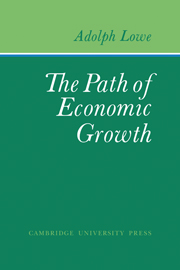Book contents
- Frontmatter
- Contents
- Preface
- Acknowledgments
- PART I The Basic Model
- PART II Changes in the Rate of Change
- 11 The Setting of the Problem
- 12 A Bird's-Eye View of an Expanding Traverse
- 13 On the Short-Period Variability of the Capital–Labor Ratio
- 14 Adjustment to a Higher Rate of Growth of Labor Supply in a Free Market. I. Structure Analysis
- 15 Adjustment to a Higher Rate of Growth of Labor Supply in a Free Market. II. Force Analysis
- 16 Adjustment to a Higher Rate of Growth of Labor Supply in a Collectivist System
- 17 Some Comments on the Role of Working Capital in the Traverse
- 18 Instrumental Analysis of Decline in the Rate of Growth of Labor Supply
- PART III Changes in the Rate of Change
- PART IV Changes in the Rate of Change
- Appendix: An Alternative Presentation of Lowe's Basic Model
- Glossary of Recurring Symbols
- Name Index
- Subject Index
13 - On the Short-Period Variability of the Capital–Labor Ratio
Published online by Cambridge University Press: 07 October 2011
- Frontmatter
- Contents
- Preface
- Acknowledgments
- PART I The Basic Model
- PART II Changes in the Rate of Change
- 11 The Setting of the Problem
- 12 A Bird's-Eye View of an Expanding Traverse
- 13 On the Short-Period Variability of the Capital–Labor Ratio
- 14 Adjustment to a Higher Rate of Growth of Labor Supply in a Free Market. I. Structure Analysis
- 15 Adjustment to a Higher Rate of Growth of Labor Supply in a Free Market. II. Force Analysis
- 16 Adjustment to a Higher Rate of Growth of Labor Supply in a Collectivist System
- 17 Some Comments on the Role of Working Capital in the Traverse
- 18 Instrumental Analysis of Decline in the Rate of Growth of Labor Supply
- PART III Changes in the Rate of Change
- PART IV Changes in the Rate of Change
- Appendix: An Alternative Presentation of Lowe's Basic Model
- Glossary of Recurring Symbols
- Name Index
- Subject Index
Summary
Even our brief survey of the major problems that arise during the adjustment of any economic system to a higher rate of growth of labor supply points up the significance of our assumption as to the fixity of the technical coefficients and, in particular, of the capital–labor ratio. It is this assumption that places capital formation in the center of analysis by excluding employment of the labor increment on the preexisting capital stock, thus calling for highly Complex shifts among the sector inputs and outputs. Subsequent investigation of the motorial conditions for the successful accomplishment of these shifts will reveal additional complications. Most of these difficulties, both real and analytical, might be circumvented if the capital-labor ratio could be varied in the short period and the labor increment simply be distributed over the three sectors, thus expanding not only employment but also output in the appropriate proportions. Therefore, to demonstrate the limits of any such solution, a more detailed exposition than has so far been given is in order.
What we are now concerned with has nothing to do with the spectrum of techniques in the sense discussed earlier. Whatever their intrinsic merits, such variations of the capital–labor ratio are of a long-period nature insofar as they require the previous formation or transformation of real capital and, thus, cannot escape the contortions of the adjustment path described.
- Type
- Chapter
- Information
- The Path of Economic Growth , pp. 115 - 122Publisher: Cambridge University PressPrint publication year: 1976



